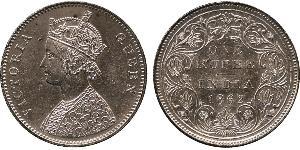1 Fanam (Verkauft für $26.0)
1790, India, Mysore, Tipu Sultan. Tiny Gold Fanam (1/10 Pagoda) Coin. XF-AU!
State: Mysore
Mint Place: Patan
Mint Year: 1790 AD (AH 1218)
Condition: A nice lustre XF-AU!
Denomination: Gold Fanam (1/10 Pagoda = 288 Copper Cash!)
Reference: Friedberg 1353, KM-128.1 var. (here with retrograde date!)
Material: Gold!
Weight: 0.39gm
Diameter: 8mm
Obverse: Retrograde islamic date (8121 for 1218 AH!) above mint name (Patan). All within inner circle. Pelletted border around.
Reverse: Letter "He" within inner circle. Pelletted border around.
The Kingdom of Mysore was a kingdom of southern India, traditionally believed to have been founded in 1399 in the vicinity of the modern city of Mysore. The kingdom, which was ruled by the Wodeyar family, initially served as a vassal state of the Vijayanagara Empire. With the decline of the Vijayanagara Empire (c. 1565), the kingdom became independent. The 17th century saw a steady expansion of its territory and during the rule of Narasaraja Wodeyar I and Chikka Devaraja Wodeyar, the kingdom annexed large expanses of what is now southern Karnataka and parts of Tamil Nadu to become a powerful state in the southern Deccan.
The kingdom reached the height of its military power and dominion in the latter half of the 18th century under the de facto ruler Haider Ali and his son Tipu Sultan. During this time, it came into conflict with the Marathas, the Nizam of Hyderabad, the Kingdom of Travancore and the British which culminated in the four Anglo-Mysore wars. Success in the first two Anglo-Mysore wars was followed by defeat in the third and fourth. Following Tipu's death in the fourth war of 1799, large parts of his kingdom were annexed by the British, which signalled the end of a period of Mysorean hegemony over southern Deccan. The British restored the Wodeyars to their throne by way of a subsidiary alliance and the diminished Mysore was transformed into a Princely state. The Wodeyars continued to rule the state until Indian independence in 1947, when Mysore acceded to the Union of India.
Even as a princely state, Mysore came to be counted among the more modern and urbanized regions of India. This period (1799–1947) also saw Mysore emerge as one of the important centers of art and culture in India. The Mysore kings were not only accomplished exponents of the fine arts and men of letters, they were enthusiastic patrons as well, and their legacies continue to influence music and art even today.
Tipu Sultan ( Urdu:ٹیپو سلطان, Kannada : ಟಿಪ್ಪು ಸುಲ್ತಾನ್ ) (20 November 1750 – 4 May 1799), also known as the Tiger of Mysore, Dipu Sultan and Tipu Sahib, was a ruler of the Kingdom of Mysore. He was the eldest son of Sultan Hyder Ali of Mysore. Tipu introduced a number of administrative innovations during his rule, including his coinage, a new Mauludi lunisolar calendar, and a new land revenue system which initiated the growth of Mysore silk industry. Tipu expanded the iron-cased Mysorean rockets and wrote the military manual Fathul Mujahidin, considered a pioneer in the use of rocket artillery. He deployed the rockets against advances of British forces and their allies in their 1792 and 1799 Siege of Srirangapatna.
Napoleon, the French commander-in-chief who later became emperor, sought an alliance with Tipu. In alliance with the French in their struggle with the British, and in Mysore's struggles with other surrounding powers, both Tipu and his father used their French trained army against the Marathas, Sira, and rulers of Malabar, Kodagu, Bednore, Carnatic, and Travancore. During Tipu's childhood, his father rose to take power in Mysore, and upon his father's death in 1782, Tipu succeeded to a large kingdom bordered by the Krishna River in the north, the Eastern Ghats in the east, and the Arabian Sea in the west. He won important victories against the British in the Second Anglo-Mysore War, and negotiated the 1784 Treaty of Mangalore with them after his father Hyder Ali suddenly died from cancer in December 1782 during the Second Anglo-Mysore War.
Tipu engaged in expansionist attacks against his neighbours. He remained an implacable enemy of the British East India Company, bringing them into renewed conflict with his attack on British-allied Travancore in 1789. In the Third Anglo-Mysore War, Tipu was forced into the humiliating Treaty of Seringapatam, losing a number of previously conquered territories, including Malabar and Mangalore. He sent emissaries to foreign states, including the Ottoman Turkey, Afghanistan, and France, in an attempt to rally opposition to the British. In the Fourth Anglo-Mysore War, the combined forces of the British East India Company and the Nizam of Hyderabad defeated Tipu, and he was killed on 4 May 1799 while defending his fort of Srirangapatna. The Karnataka Government has been lately trying to portray Tipu Sultan as a State Hero. He is regarded a hero in Pakistan as well, and the PNS Tippu Sultan ships of the Pakistan Navy are named after him. But outside the old region of Mysore, in some South Indian regions such as Kodagu, Malabar, and Dakshina Kannada, Tipu has been accused of religious bigotry.

|
Beigetragen von:
anonymous 2015-10-07 |
|
||
|
||
|
||
|
||




 English
English












